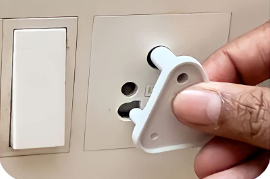Becoming a parent is a joyful and transformative experience, but it also comes with the responsibility of ensuring your child’s safety. As babies and toddlers explore their surroundings with curiosity and eagerness, childproofing your home becomes an essential step in preventing accidents and creating a secure environment. In this comprehensive guide, we’ll walk you through the process of childproofing, offering suggestions, and even some DIY ideas to make your home a safe haven for your little one.
1. Begin with a Thorough Inspection
Before you dive into childproofing, it’s essential to see your home from your child’s perspective. Get down on your hands and knees to discover potential hazards you might overlook from an adult’s height. Take note of sharp edges, reachable objects, and electrical outlets.
2. Install Safety Gates
Safety gates are invaluable for keeping your child away from dangerous areas, such as stairs. Install them at the top and bottom of staircases and any room you want to designate as off-limits. Look for gates that are sturdy and can be securely attached without damaging your walls.
3. Secure Furniture
Children love to climb, and unsecured furniture can tip over easily. Secure heavy furniture, like bookshelves and dressers, to the wall using anti-tip straps or brackets. Ensure that TVs are also anchored securely.
4. Childproof Cabinets and Drawers
Cabinets and drawers can hide a variety of dangers, from cleaning products to sharp utensils. Use childproof latches or locks to prevent little hands from accessing these hazards. Some simple DIY options include installing childproof locks or using zip ties to secure cabinet handles.
5. Cover Electrical Outlets
Outlet covers or plug protectors are essential for preventing electrical shocks. These inexpensive plastic covers are simple to install and make outlets inaccessible to small fingers.
6. Window Safety
Windows can be fascinating for children, but they also pose a falling risk. Install window guards or stops to limit how far windows can open. Ensure that blind cords are out of reach or use cordless blinds.
7. Edge and Corner Protectors
Soft edge and corner protectors can help prevent injuries caused by sharp furniture edges. You can find a variety of options, from stick-on foam protectors to corner cushions.
8. Use Door Stoppers
Little fingers can get pinched in doors. Install door stoppers or door holders to prevent doors from slamming shut.
9. Cover Radiators and Heaters
Radiators and heaters can get scorching hot. Use radiator covers or install safety gates to keep your child away from them.
10. Secure Appliances
Appliances like ovens, dishwashers, and refrigerators can be enticing to little ones. Consider appliance locks or latches to prevent them from opening or accessing potentially dangerous items.
11. Baby-Proof Sharp Edges
Sharp furniture corners and edges can lead to painful bumps and bruises. Soften these areas with edge guards, which come in various shapes and sizes.
12. Keep Small Objects Out of Reach
Small items like coins, buttons, and batteries can pose choking hazards. Regularly scan your floors for small objects, and make sure your child’s play area is free of these items.
13. Install Toilet Locks
Toilets are a source of fascination for many children. Prevent drowning hazards by installing toilet locks or latches.
14. Use Cord Organizers
Long cords from blinds, curtains, or electronics can pose strangulation risks. Use cord organizers to keep them out of reach.
15. Secure Rugs and Carpets
Rugs and carpets can be trip hazards. Use non-slip rug pads to secure them in place, especially in areas where your child plays.
16. Cover Sharp Radiator Corners
Radiators can have sharp corners that are eye-level for toddlers. Consider radiator covers to prevent injuries.
17. Lock Away Harmful Products
Store cleaning supplies, medications, and other hazardous substances out of your child’s reach in locked cabinets.
18. Set Up Safety Checks
Periodically conduct safety checks in your home to ensure that childproofing measures are still in place and functioning correctly.
19. Teach Your Child About Safety
As your child grows, teach them about safety rules and boundaries. Explain why certain areas or objects are off-limits and how to use safety measures correctly.
20. Seek Professional Advice
If you’re unsure about childproofing or need assistance, consider consulting a professional childproofing service. They can assess your home and provide personalized recommendations.
Childproofing your home is an ongoing process that evolves as your child grows and becomes more mobile. Regularly reassess your childproofing measures to ensure they remain effective. Remember, childproofing isn’t just about creating a safe environment; it’s also about providing your child with the freedom to explore and learn in a secure space. By taking these steps, you’re not only safeguarding your child but also creating a nurturing home where they can thrive and grow.


